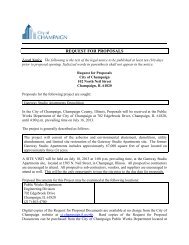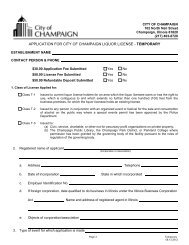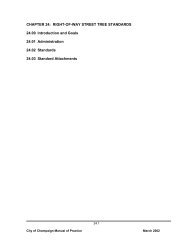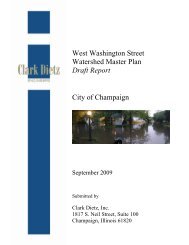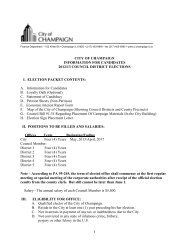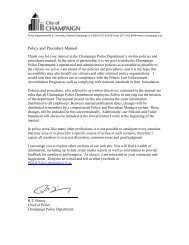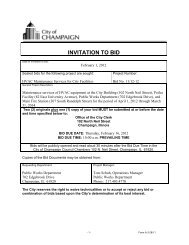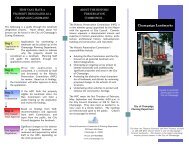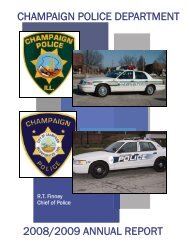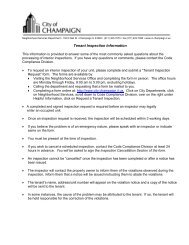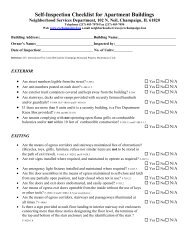2010-2014 Consolidated Plan - City of Champaign
2010-2014 Consolidated Plan - City of Champaign
2010-2014 Consolidated Plan - City of Champaign
Create successful ePaper yourself
Turn your PDF publications into a flip-book with our unique Google optimized e-Paper software.
median income. In this Annual Action <strong>Plan</strong>, strategies and activities that are targeted to low- andmoderate-income areas are <strong>of</strong>ten noted to be targeted to the <strong>Plan</strong>ning Areas containing large amounts <strong>of</strong>red on this map.Each <strong>of</strong> these <strong>Plan</strong>ning Areas contains specific neighborhoods known to residents by other names.<strong>Plan</strong>ning Area 1 contains the Bristol Place, Beardsley Park, and Garden Park neighborhoods. <strong>Plan</strong>ningArea 2 contains the Douglass Park, Douglass Square, Carver Park, Crispus Attucks, and Taylor Thomasneighborhoods. <strong>Plan</strong>ning Area 4 contains the Sesquicentennial, Spalding and Maple/Vine neighborhoods.<strong>Plan</strong>ning Area 7 consists primarily <strong>of</strong> the Dobbins Downs neighborhood. <strong>Plan</strong>ning Area 8 is known asGarden Hills and <strong>Plan</strong>ning Area 14 is Holiday Park.<strong>Plan</strong>ning Area 3, which also contains a high percentage <strong>of</strong> low- and moderate-income households, ismentioned infrequently throughout the Annual Action <strong>Plan</strong>. This area, known as the University District, isprimarily occupied by University <strong>of</strong> Illinois students living in certified housing or privately ownedapartments. Although they may be low-income households while they are in school, this condition istemporary. Also, most <strong>of</strong> these students receivesignificant amounts <strong>of</strong> family subsidy. Therefore,very few affordable housing or communitydevelopment programs are targeted to thestudent population.<strong>Plan</strong>ning Area 2 contains a disproportionatelyhigh percentage <strong>of</strong> minority households ascompared to the remainder <strong>of</strong> the <strong>City</strong>. Areascontaining a high concentration <strong>of</strong> minorityhouseholds are depicted in the green colors onthis thematic map. Areas 1, 4, 8, and 9 alsocontain slightly higher concentrations <strong>of</strong> minorityhouseholds than do the remainder <strong>of</strong> theplanning areas in the <strong>City</strong>. As indicated on thesetwo maps, the low/mod areas and the areas <strong>of</strong>higher minority concentration are closely aligned.Exhibit 2GEOGRAPHIC BASIS FOR ALLOCATING INVESTMENTSThe <strong>City</strong> will use income data from the U.S. Census and neighborhood condition data collected throughthe Neighborhood Wellness <strong>Plan</strong> update process to determine where and how to direct federal fundingand other assistance during the coming year. This same method will be in place for each year <strong>of</strong> thefive-year <strong>Consolidated</strong> <strong>Plan</strong>. The <strong>City</strong>’s goal is to periodically update Neighborhood Wellness data so that<strong>City</strong> services can be shifted as necessary to meet changing neighborhood conditions. If these changingconditions significantly impact the <strong>City</strong>’s targeting <strong>of</strong> federally funded activities, those changes will bedescribed in the next five-year <strong>Consolidated</strong> <strong>Plan</strong>.FY <strong>2010</strong>/11 Annual Action <strong>Plan</strong>: Geographic Distribution and Housing Market Analysis 105



